Life at the Lake
a diary of living at a small lowland lakeWHAT IT'S LIKE
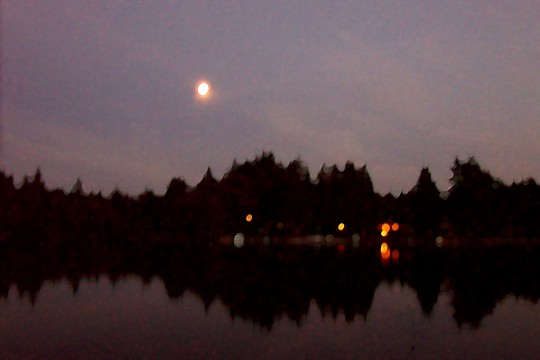
Early moonrise over Lake Ketchum
|
Archive Search |
| Links |
|
and s-integrator |

O Canada!
Here's my plan.
The US has recently invaded two small Muslim countries. They are believed to harbor terrorists who threaten our domestic security.
They are far away and necessitate long supply lines for our military ground operations. The people speak some sort of gibberish, not English. And the fools don't observe the Geneva Convention. They fight any way they can. It is their homeland, after all. Now that the war is officially over, they won't stop killing us.
It's not fair. It is like playing cards with people who habitually cheat. This is not the American way, darn it.
Here's my solution. We are in need of another small country with a docile population, and no large standing army, for us to invade.
Why not Canada?
Don't laugh. They have a large Muslim population. They don't really like us and feel that our popular culture has already invaded their country for a couple of hundred years and is despicable. We have bad taste—which is even worse than bad breath. And they feel they are superior to us. As my Canadian friend, Bob Taylor, said to me, right on the heels of the Kennedy assassination (the first one), "Why do you Americans always kill your Presidents?"
Good question, though one with undeniable malicious intent. I've always wanted to pay Bob back for the cruel slam. Let's invade his country. It seems a reasonable retribution.
But, seriously folks, if we did dare to invade Canada, we'd find we have very short supply lines, a long border along which to attack them—Washington, Idaho, N. Dakota, Minnesota, Wisconsin, Ohio, even New York and Maine. Take your pick for keen invasion sites.
And they speak our language, even though they pronounce "about" as "aboot," which is pretty silly. In spite of things like that, there would be no big language barrier. When we shouted, "Surrender, you dumb bastards," they'd know exactly what we meant. It would be a fair war—if there is such a thing. And I doubt whether their womenfolk would approach us, all smiles and wriggles, then blow us up with bombs strapped beneath their comely long black frocks.
It's only logical. A modest proposal, in a time of many immoral ones. And—George Bush, please note—I've queried Tony Blair about the invasion prospect.
He's all in favor of it. He thinks it would be a smart move.
- - Comments ()
...
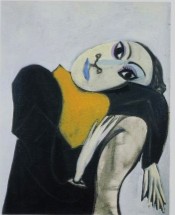
Picasso, "Dora Maar in a Yellow Scarf Her Head Leaning to the Side," 1936
They met, appropriately, one night at the Cafe des Deux Magots, in 1936. It was lust at first sight, according to Jean-Paul Crespelle, who was there. Picasso was with his friend, Paul Eluard:
". . .the young woman's serious face, lit up by pale blue eyes which looked all the paler because of her thick eyebrows; a sensitive uneasy face, with light and shade passing alternately over it. She kept driving a small pointed pen-knife between her fingers into the wood of the table. Sometimes she missed and a drop of blood appeared between he roses embroidered on her black gloves. . . . Picasso would ask Dora to give him the gloves and would lock them up in the show case he kept for such mementos."
Author Mary Ann Caws continues the tale: "Picasso addressed Dora in French, which he assumed to be her language; she replied in Spanish, which she knew to be his." Picasso remarked in his native Spanish to Eluard about her beauty. Of course Dora understood Spanish. She smiled. They left together shortly afterwards.

Dora Maar, "The Quays of the Seine," 1944
They were inseparable for seven years. No, that isn't exactly right. Picasso saw her whenever he wanted, insisting she have her own place and not come to his studio unless specifically invited.
Shortly before meeting Dora, he had an affair with Marie-Therese Walter, with whom he had a daughter, Maya. He continued to see them and seemingly enjoyed Dora's resulting fury. Since Dora bore him no child, some biographers feel he minimalized his relationship with her, intense as it was, and found it easy to abandon her for Françoise Gilot.
Later, Dora was heard to say, "I wasn't Picasso's mistress; he was just my master."
She learned a lot.
- - Comments ()
...
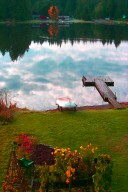
The lake from my dock, with no bloom
(Short digression from the Picasso/Maar affair.)
The lake is in bloom! Once a year, about this time, or earlier, the lake undergoes a startling transformation. It turns a brilliant smoky green. It frightens people who have never seen it. It lasts a week or longer, and then the lake returns to vestiges of its former clean source.
Ten days ago I remarked on the water clarity. It measured 3.3 meters and was unheard of. Well, that was then, this is now. I can see down about half a meter. And then everything disappears.
Perch can no longer see well enough to strike a lure. True, the worm fishers are still getting them. Perch reach aggressively to sight objects that invade their territory. Not now. But they can still smell and taste. There are still a number of boats anchored on the lake, still fishing with floats and long leaders baited with worms (or maggots, for the less than fastidious).
I got a call yesterday from a friend on the lake whose grandchildren had arrived for a swim. (Temp was 92 degrees F.) Was it safe, she wanted to know? I said it was, but as a precaution to take a shower afterwards. (I presume with soap.)
I started to tell an aging vignette about my wife and I living in a houseboat on Seattle's Lake Union, back in our school days, and how I swam unscathed in that filthy lake daily, after studying for my MA exam, always hosing off in the shower, with no ill effects, but Gertie was in a hurry and rang off, leaving me dangling in mid-nostalgia.
The grandkids were headed toward the water.
Luckily there is no accompanying bloom of blue/green algae, which is toxic and can harm small dogs and cats, not to mention people, if ingested in huge quantities. Most years there is, and it has a superficial likeness to this kind of harmless bloom, which only indicates green algae in the water column maturing and dying.
Soon it will be over, I know, and the tiny dead particles will sink to the bottom and add to the enriched nutrients in the lake that cause more algae, in the form of surface scum, to grow rapidly.
No acceptable pesticide exist for treating it, and the only solution is to wade out after it and rake it up and let it dry on the beach. It makes excellent garden fertilizer.
Tomorrow more of the Dora Maar saga.
- - Comments ()
...
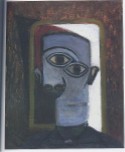
Dora Maar, Portrait of Picasso, c.1938
Dora Maar was Picasso's lover from 1937 to 1944, though he had numerous affairs and fathered children during that time. Dora remained faithful, so far as we know, and there is no evidence to the contrary.
She was a devoted mistress and apprentice. A photographer already recognized by her peers her work—viewed in Mary Ann Caw's book cited yesterday—is still strong, and compares well with Brassai and Man Ray, who were friends of her and Picasso. Her documentary photos of the preparatory work for Guernica are invaluable in understanding how Picasso thought and worked, and how carefully he prepared and executed this complex mural.
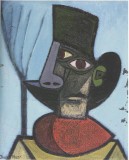
Dora Maar, "Portrait of Picasso in a Black Hat, 1942
Maar's own work evolved during the many decades that followed her breakup with Picasso and her productive seclusion. I mean, starting on so an advanced level, with Picasso out of the picture, and her obvious competition with him dissolved, it might be expected that her work would take a downward slant.
It did not. She continued in an upward direction with wonderful, mature portraits (Alice B. Toklas is one of her finest) and, late in life, abstract land- and seascapes that are richly rewarding.
More anon.
- - Comments ()
...
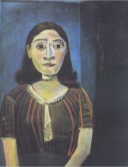
Pablo Picasso, Portrait of Dora, about 1942
Next to Picasso, nobody is a very good painter.
Dora Maar was next to Picasso for seven years, but she evolved into a very fine painter. Much of her earlier work bore a strong Cubist resemblance to the Master, but after she broke with him (his idea, of course; he'd found a new, younger mistress) her art flourished in decades of nearly total quasi-religious isolation.
As she said, "After Picasso, Only God." One is never sure whether this was a step up or down for her.

Pablo and Dora; cute couple, aren't they?
She was a recognized photographer when she met him. Picasso loved photography and frequently took his own picture in his studio, amid his stacks of paintings. And he loved to be photographed, always looking into the camera with a stare of absolute confidence.
Often they painted side by side in his studio. She copied him (a great way to learn how to paint, incidentally) and in my opinion only sometimes surpassed him in similar, quickly executed studies.
Picasso maintained that "in every photographer there was a painter, a true artist, awaiting expression." [Quote is from Mary Ann Caws excellent book on Dora, Picasso's Weeping Woman, The Life and Art of Dora Maar (Bulfinch, 2000).]
More of her fine paintings and details from her life to follow in later editions of this blog.
- - Comments ()
...

A school of yellow perch. all lined up for the underwater camera
A week ago I was astonished by the enormous clarity of lake water (3.3 m.); only five days later, the water is clouded with suspended algae particles. The lake has taken on a milky green-brown cast.
I'm not surprised. With no rain, a hot sun daily, and the amount of phosphorous and nitrogen fed into this lake from a largely abandoned dairy farm, we have all the wrong conditions. To have been blessed nearly to the end of July with warm, clear water was wonderful. Now we must endure what truly is the opposite of a blessing, a bane.
Trout fishing stopped, for all productive purposes, just after the Fourth. But fishers are coming to the lake in large numbers for the yellow perch. Each year the numbers of these easily caught fish are reproduced greatly, and provide fun and food for many people—though I suspect a lot of dead perch get deposited to the nation's stinking garbage cans.
They are a bit hard to clean and are full of bones. Only the skillful can fillet them deftly. They aren't bad eating, if you like greasy fried food of indeterminate flavor. Lots of folks do.
Well, I was catching and releasing them fairly easily (one fish for about every fifteen casts) off my dock, at twilight, as the Mariner's opponents came up to bat. That is, I did until the water clouded with algae. The took my little feathered spinner, hitting hard. But now they can't seem to see it.
The worm fishers, with their floats and long leaders, are catching perch in sufficient quantities to keep schools of them (fishers, that is) coming back, often three to a boat.
There is no legal limit. I mean, to the number of perch you can catch and kill. I guess there are limits to how many avid fishers you can jam into a single boat.
___________________________
Letters to the Editor (Seattle-PI) we never finished reading:
"As a longtime lesbian activist, I want to join my community in raising a champagne glass of congratulations to Seattle' s Pride Foundation. . . . Sarah Luthens," July 28, 2003
- - Comments ()
...

Not California, but the poppies are from there
Back to the lake, after a sojourn into the realms of jazz.
The lake is constant, but ever changing. Does that make any sense? Need it?
A week ago, a Sunday, I took measurements of the lake for the county, as part of its monitoring effort for the EPA and the Clean Waters Act.
I could not believe my Secchii disc readings: 3.3 meters. (This is a measure of how deeply you can see into the lake from the surface; I lower a big white and black metal plate and record the depth in fractions of a meter until I can no longer see the disc.)
I took them again, from the other side of the anchored boat, in the deepest part of the lake. Same thing. This is the clearest the lake has been within my memory, which is now seven years. What is more, it is clearer by about a meter. That is 40 inches, give or take one or two.
No rain in weeks. This is most unusual for the Pacific Northwest. It is almost desert conditions. Yard sprinklers are going everywhere. Where they haven't been turned on, the grass is toast.
In the shallows, when I start to walk out on my dock, I see large-mouth bass fry of two distinct sizes. They are hatched during the same spring, but weeks apart, for bass have a long spawning season. And now there are young bluegills among them, or, rather, darting along the shoreline, in and out of the cover of cinquefoil, cattails, and overhanging grasses.
The bluegill fry mimic closely the adults. They disdain moving about as schools and elect a lifestyle as individuals. (Love 'em for that!) They are shy little creatures, paler in color than the small bass. They drift about, with a peculiar little wiggle.
Those bass are now feeing actively on insects and in the evening when the midges hatch out dimple the water and give the impression of raindrops falling.
If only they would.
- - Comments ()
...